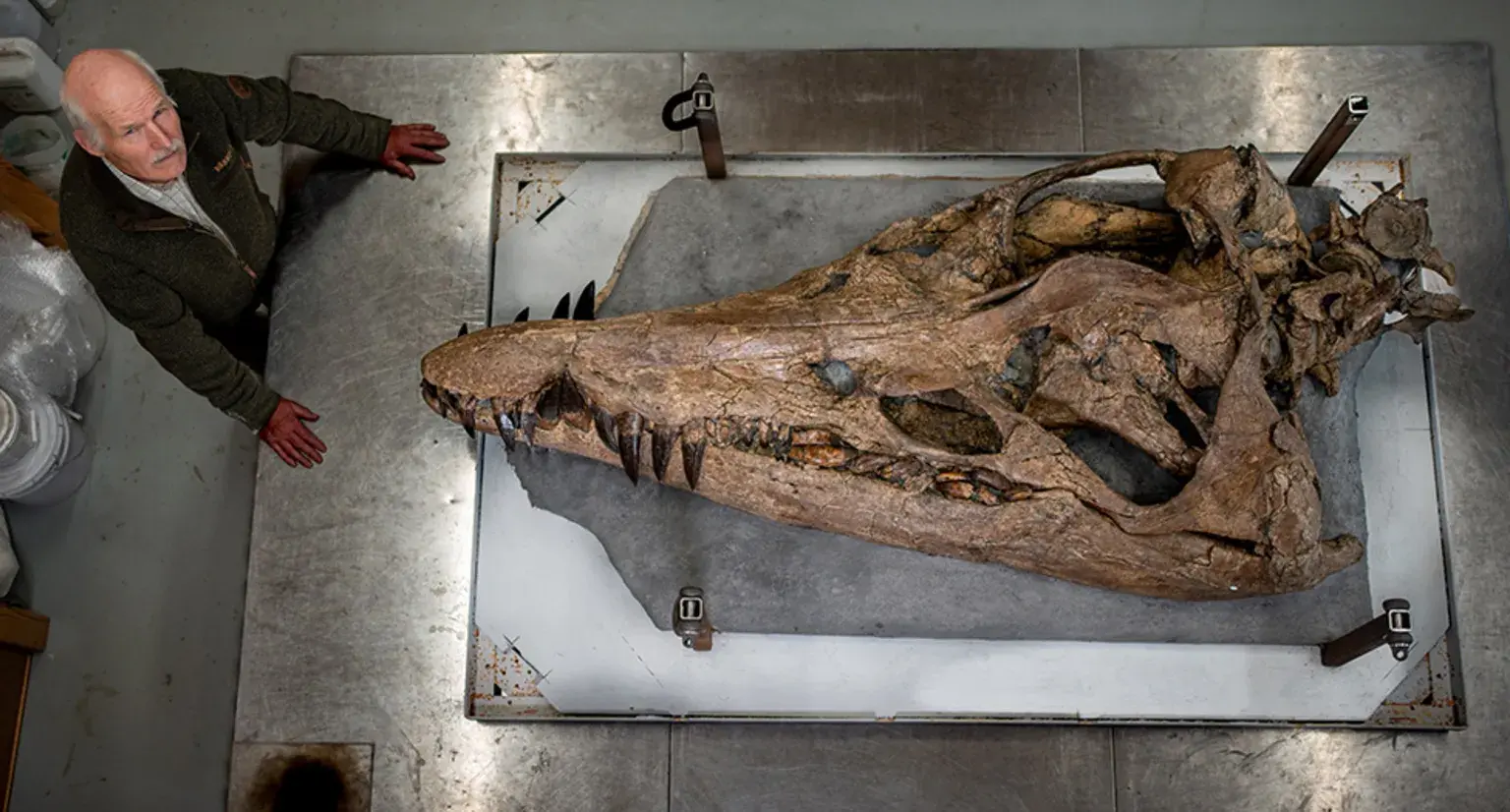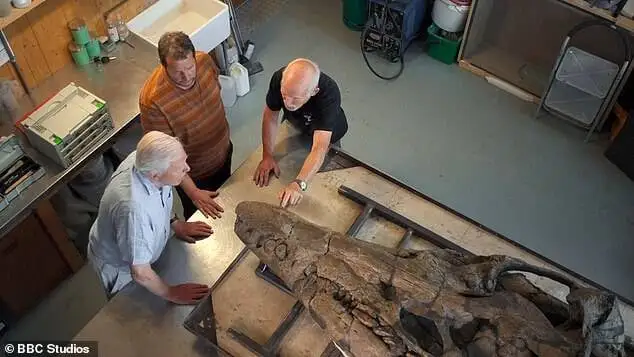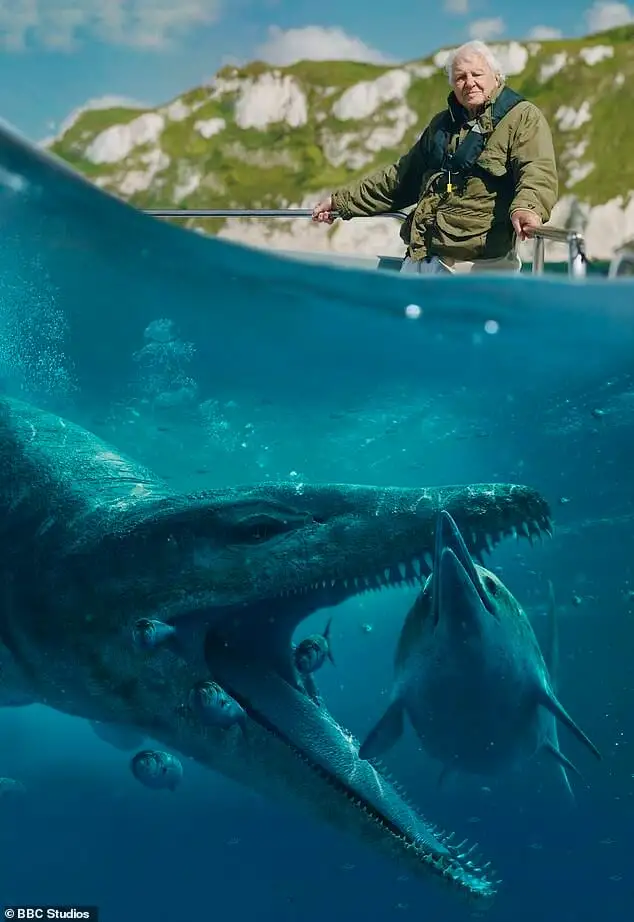This pliosaur was about the size of a double-decker bus and was so formidable that scientists are calling it “the T Rex of the seas.”

Tony Jolliffe/BBCThe massive skull of the pliosaur measured nearly six and a half feet long.
Paleontologists just extracted an enormous skull fossil from the cliffs of Kimmeridge Bay in England. Now, researchers believe it may be from a completely new species of Jurassic sea monster.
Last year, fossil enthusiast Phil Jacobs was strolling along the “Jurassic Coast,” a World Heritage Site that covers a 95-mile-long stretch of coastline along the English Channel, when he came across a strange fossil. Jacobs immediately alerted his friend, paleontologist Steve Etches, to the discovery.
It turned out that Jacobs had stumbled upon the jaw of a pliosaur, a monstrous reptile that dominated the seas nearly 150 million years ago. These giant creatures could measure 32-39 feet long — “about the size of a double-decker bus,” according to David Attenborough.
“There’s nothing comparable to it today,” Etches said, according to the Daily Mail. “It’s a big carnivorous reptile and one of the largest that ever lived in the sea. It’s even bigger than a T-Rex, these are larger and more ferocious.”
The fossil Jacobs found was too heavy to lift, so he and Etches returned with a drone to relocate it. A team of paleontologists and climbers was later assembled to excavate the site. While dangling on ropes from the cliffside about 36 feet off the ground, they uncovered not only the jaw, but a nearly complete pliosaur skull.

BBC StudiosThe pliosaur fossil had to be carefully excavated from the side of a cliff on England’s “Jurassic Coast.”
“It was very exciting but, thinking logistically, not a good place to collect a fossil from,” Etches said, according to The Guardian. “The cliffs are sheer, crumbling and unsafe, eroding quickly. It’s a very dangerous area — with large rockfalls and slippery ledges — so safety was paramount.”
The skull measures a staggering 6 feet and 5 inches long and contains about 130 razor-sharp teeth, each of which is ridged at the back to help it slice into its prey. Scientists say this discovery is one of the most complete pliosaur skulls ever found and may even represent an entirely new species.

BBC StudiosSir David Attenborough and Dr. Steve Etches examine the skull of the pliosaur.
Pliosaurs were the apex predators of the Jurassic seas approximately 150 million years ago. The force of this sea monster’s bite is estimated to have been 33,000 newtons — more than twice that of a saltwater crocodile, whose jaws are more powerful than any other living animal’s at 16,000 newtons.
“The animal would have been so massive that I think it would have been able to prey effectively on anything that was unfortunate enough to be in its space,” said Dr. Andre Rowe from Bristol University in an interview with BBC News. “I have no doubt that this was sort of like an underwater T. rex.”
The skull of the pliosaur featured a snout dotted with small indents. Scientists theorize these were once the sites of glands used to detect changes in water pressure caused by the movements of its prey.
The specimen also had a parietal third eye on its head, similar to those seen in today’s lizards, frogs, and some fish; this eye would have been light sensitive, allowing the pliosaur to see its prey in the murky waters it called home.
This discovery will be featured in the new David Attenborough documentary Attenborough and the Giant Sea Monster, which will premiere on BBC on New Year’s Day. The film follows the research team throughout this extraordinarily difficult excavation process, as well as their research into the life of this Jurassic sea monster.

BBC StudiosAttenborough and the Giant Sea Monster, a new BBC documentary set to release on New Year’s Day 2024, follows the excavation of the pliosaur fossil.
Etches believes that the rest of the pliosaur’s remains could still be buried within the cliffs of the Jurassic Coast. Over time, through the process of erosion, the cliffs may naturally reveal what was buried on the ocean floor millions of years ago.
“I stake my life the rest of the animal is there,” Etches said. “And it really should come out because it’s in a very rapidly eroding environment. This part of the cliff line is going back by feet a year. And it won’t be very long before the rest of the pliosaur drops out and gets lost. It’s a once in a lifetime opportunity.”
Earlier this year, another new species of pliosaur fossils was discovered at the Abingdon County Hall Museum in the United Kingdom, where the “ginormous” bones were found hidden away in storage.





